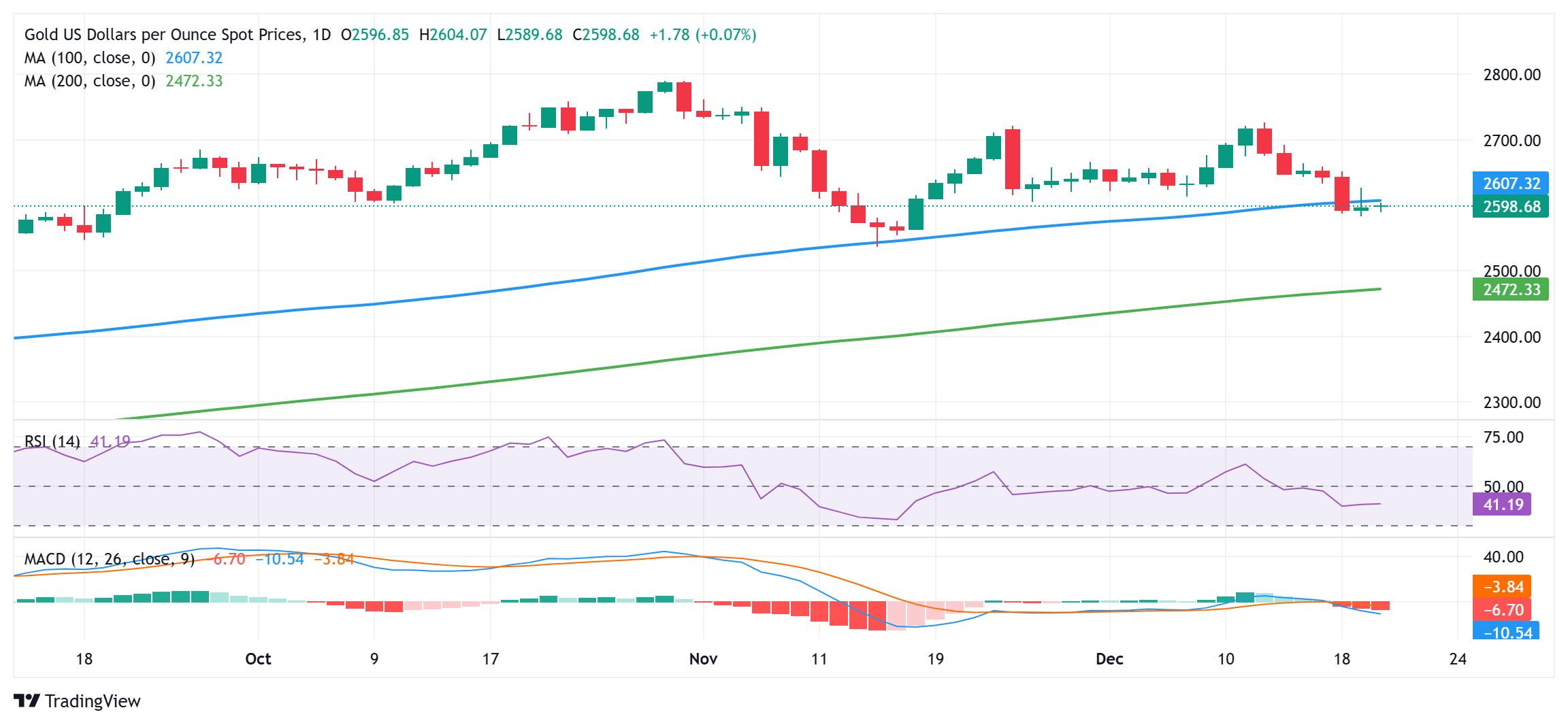Gold price holds steady around $2,600; upside potential seems limited
- Gold price attracts some haven flows amid the looming risk of a US government shutdown.
- The global flight to safety-led pullback in the US bond yields further benefits the XAU/USD.
- The Fed’s hawkish stance acts as a tailwind for the USD and should cap any further upside.
Gold price (XAU/USD) attracts some dip-buyers following the previous day's good two-way price moves and climbs back to the $2,600 mark during the Asian session on Friday. Against the backdrop of persistent geopolitical risks, trade war fears and the Federal Reserve's (Fed) hawkish shift, the threat of a partial US government shutdown ahead of the Friday night deadline drives some haven flows towards the precious metal.
The flight to safety leads to a modest pullback in the US Treasury bond yields, which keeps a lid on the recent US Dollar (USD) rally to a two-year top and turns out to be another factor lending support to the commodity. That said, the Federal Reserve's (Fed) hawkish signal that it would slow the pace of rate cuts in 2025 should act as a tailwind for the US bond yields and the USD, which, in turn, caps the non-yielding yellow metal.
Gold price draws support from haven flows; bulls seem non-committed amid the Fed’s hawkish shift
- The US House of Representatives on Thursday failed to pass A spending bill to fund the government, raising the risk of a government shutdown at the end of the day on Friday.
- This comes on top of persistent geopolitical risks and concerns about US President-elect Donald Trump's tariff plans, which, in turn, drive some haven flows towards the Gold price.
- The US Treasury bond yields retreat from a multi-month top, capping the post-FOMC blowout US Dollar rally to a two-year top and lending additional support to the commodity.
- The US Bureau of Economic Analysis reported on Thursday that the economy expanded at a 3.1% annualized pace in the third quarter compared to 2.8% estimated previously.
- Other data on Thursday showed that the number of Americans filing new applications for jobless benefits fell more than expected, to 220K for the week ended December 14.
- This reaffirms the Federal Reserve's hawkish outlook for a slower rate cut path in 2025, which should act as a tailwind for the US bond yields and cap the non-yielding yellow metal.
- Bulls might also refrain from placing aggressive bets ahead of Friday's release of the US Personal Consumption Expenditure (PCE) Price Index – the Fed's preferred inflation gauge.
Gold price technical setup supports prospects for the emergence of fresh sellers at higher levels

From a technical perspective, the post-FOMC slump below the 100-day Simple Moving Average (SMA) was seen as a fresh trigger for bearish traders. Moreover, oscillators on the daily chart have been gaining negative traction and suggest that the path of least resistance for the Gold price is to the upside. Hence, any subsequent move up might continue to face immediate resistance near the overnight swing high, around the $2,626 region. Some follow-through buying, however, might trigger a short-covering rally and lift the XAU/USD to the next relevant hurdle near the $2,652-2,655 supply zone. A sustained strength beyond the latter could negate the negative bias and pave the way for additional gains.
On the flip side, the monthly low, around the $2,583 region touched on Thursday, could protect the immediate downside, below which the Gold price could drop to the $2,560 area en route to the $2,537-2,536 zone or the November swing low. The downward trajectory could extend further towards the $2,500 psychological mark before the XAU/USD eventually drops to the very important 200-day SMA support, currently pegged near the $2,472 region.
Gold FAQs
Gold has played a key role in human’s history as it has been widely used as a store of value and medium of exchange. Currently, apart from its shine and usage for jewelry, the precious metal is widely seen as a safe-haven asset, meaning that it is considered a good investment during turbulent times. Gold is also widely seen as a hedge against inflation and against depreciating currencies as it doesn’t rely on any specific issuer or government.
Central banks are the biggest Gold holders. In their aim to support their currencies in turbulent times, central banks tend to diversify their reserves and buy Gold to improve the perceived strength of the economy and the currency. High Gold reserves can be a source of trust for a country’s solvency. Central banks added 1,136 tonnes of Gold worth around $70 billion to their reserves in 2022, according to data from the World Gold Council. This is the highest yearly purchase since records began. Central banks from emerging economies such as China, India and Turkey are quickly increasing their Gold reserves.
Gold has an inverse correlation with the US Dollar and US Treasuries, which are both major reserve and safe-haven assets. When the Dollar depreciates, Gold tends to rise, enabling investors and central banks to diversify their assets in turbulent times. Gold is also inversely correlated with risk assets. A rally in the stock market tends to weaken Gold price, while sell-offs in riskier markets tend to favor the precious metal.
The price can move due to a wide range of factors. Geopolitical instability or fears of a deep recession can quickly make Gold price escalate due to its safe-haven status. As a yield-less asset, Gold tends to rise with lower interest rates, while higher cost of money usually weighs down on the yellow metal. Still, most moves depend on how the US Dollar (USD) behaves as the asset is priced in dollars (XAU/USD). A strong Dollar tends to keep the price of Gold controlled, whereas a weaker Dollar is likely to push Gold prices up.

